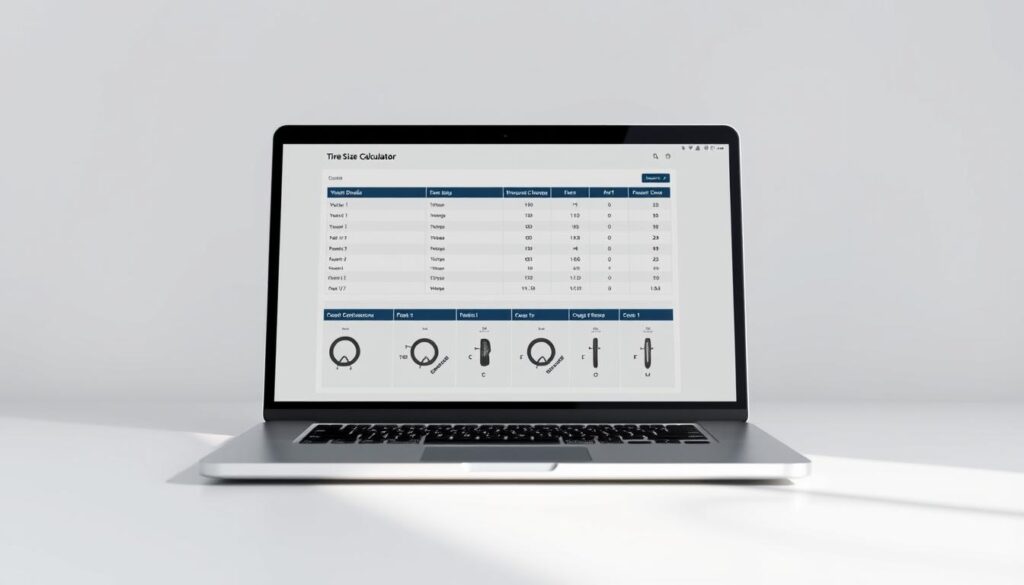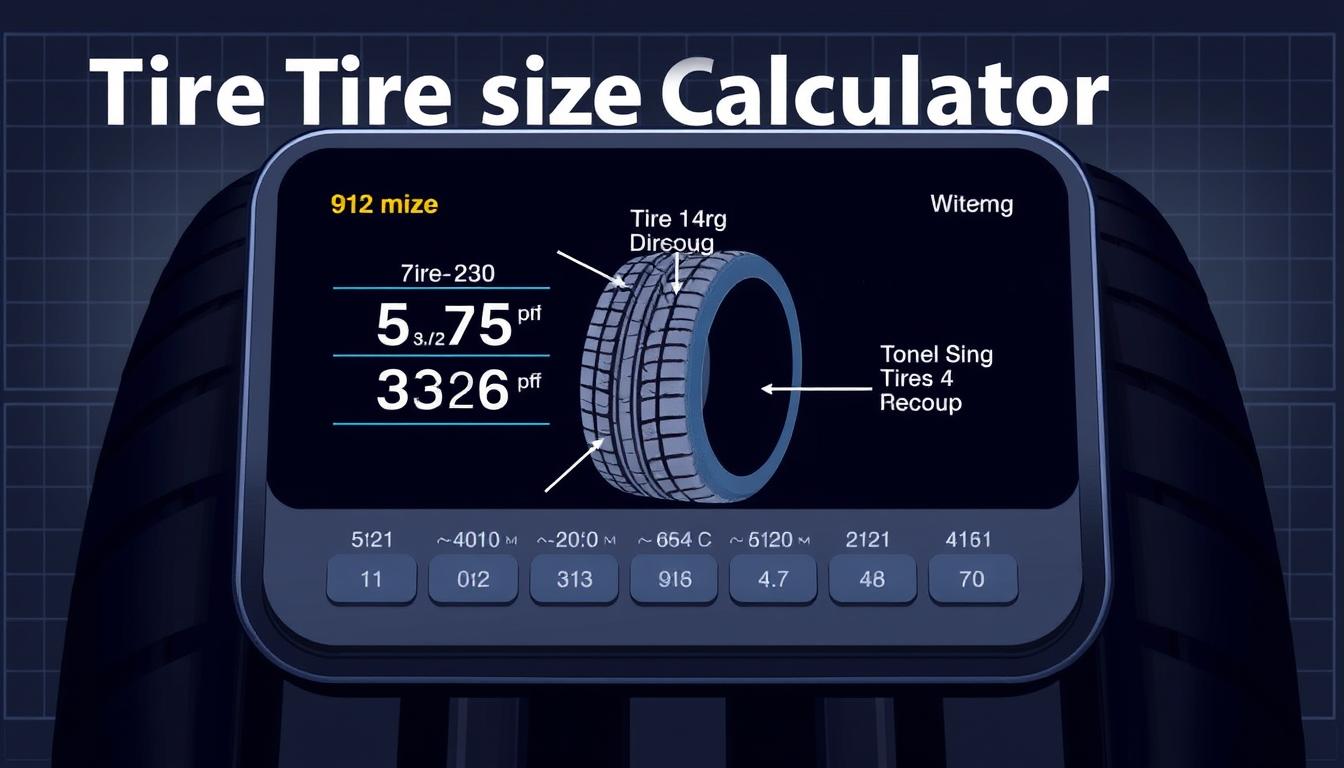Determining the ideal tire size for your vehicle is crucial for its performance and safety. The FORScan tire size calculator is a valuable tool that helps vehicle owners make informed decisions when modifying or replacing their tires.
Using this calculator, you can ensure that your vehicle’s performance and safety are not compromised. It provides an accurate tire size calculation, taking into account various factors that affect your vehicle’s overall performance.
Key Takeaways
- Understand the importance of ideal tire size for vehicle performance and safety.
- Learn how the FORScan tire size calculator works.
- Discover the benefits of using a tire size calculator.
- Get insights into the factors that affect tire size calculation.
- Make informed decisions when modifying or replacing your vehicle’s tires.
What is FORScan and Its Core Functionality
FORScan has emerged as a leading diagnostic solution for a wide range of Ford, Lincoln, Mazda, and Mercury vehicles. This powerful diagnostic tool is designed to provide vehicle owners and mechanics with advanced diagnostic capabilities, allowing them to troubleshoot and resolve issues efficiently.
Overview of FORScan Diagnostic Software
FORScan diagnostic software is engineered to work seamlessly with the onboard diagnostics (OBD) systems of compatible vehicles, providing real-time data and diagnostic trouble codes (DTCs). The software is highly versatile, supporting a broad spectrum of vehicle models and years, making it an indispensable tool for both professional mechanics and DIY enthusiasts.
Compatible Ford, Lincoln, Mazda, and Mercury Vehicles
FORScan is compatible with a vast array of vehicles from Ford, Lincoln, Mazda, and Mercury. The software supports various models and years, ensuring that users can access detailed diagnostic information and perform necessary adjustments. Some of the supported vehicles include:
| Manufacturer | Models | Years |
|---|---|---|
| Ford | F-150, Mustang, Fusion | 2004-2022 |
| Lincoln | Navigator, MKZ, Continental | 2005-2022 |
| Mazda | Mazda3, CX-5, CX-9 | 2006-2022 |
| Mercury | Mariner, Milan, Mountaineer | 2004-2011 |
Primary Features and Capabilities
The core functionality of FORScan includes advanced diagnostic capabilities, such as reading and clearing DTCs, performing actuator tests, and accessing real-time data streams. Additionally, FORScan allows users to configure and customize various vehicle settings, enhancing the overall driving experience. As noted by a leading automotive expert, “FORScan is a game-changer in the world of vehicle diagnostics, offering unparalleled depth and flexibility.”
“FORScan is a game-changer in the world of vehicle diagnostics, offering unparalleled depth and flexibility.”
By leveraging these features, users can gain a deeper understanding of their vehicle’s performance and make informed decisions to optimize its operation.
The Importance of Correct Tire Sizing
Proper tire sizing is essential for maintaining the balance between vehicle performance, safety, and fuel efficiency. Incorrect tire sizes can lead to compromised handling, reduced safety, and decreased fuel economy.
How Tire Size Affects Vehicle Performance
Tire size significantly impacts a vehicle’s handling, braking, and acceleration. Larger tires can improve handling and braking performance, but may also increase stopping distances if not properly matched to the vehicle’s specifications. Conversely, smaller tires may result in reduced traction and compromised handling.
Safety Implications of Incorrect Tire Sizes
Using incorrect tire sizes can have serious safety implications. It can lead to uneven tire wear, reduced traction, and increased risk of tire failure. Moreover, incorrect tire sizes can affect the vehicle’s stability, particularly at high speeds, thereby increasing the risk of accidents.
Impact on Fuel Economy and Drivetrain Components
Tire size also affects fuel economy and drivetrain components. Oversized tires can decrease fuel efficiency due to increased rolling resistance, while undersized tires may lead to increased engine load, also negatively impacting fuel economy. Furthermore, incorrect tire sizes can put additional stress on drivetrain components, potentially leading to premature wear and failure.
In conclusion, correct tire sizing is vital for ensuring optimal vehicle performance, safety, and fuel efficiency. Vehicle owners should consult their vehicle’s manufacturer specifications to determine the appropriate tire size for their vehicle.
Understanding Tire Size Terminology and Measurements
To make informed decisions about your vehicle’s tires, it’s essential to grasp the basics of tire size terminology and measurements. Tire size is not just a number; it’s a complex code that contains vital information about the tire’s dimensions and capabilities.
Decoding Tire Size Markings (P-Metric, Euro-Metric, LT)
Tire size markings can be categorized mainly into P-Metric, Euro-Metric, and LT (Light Truck) types. P-Metric tires are the most common and are designed for passenger vehicles. Euro-Metric tires are similar but are used more commonly outside the United States. LT tires are designed for light trucks and have different load-carrying capabilities.
A typical tire size is represented in a format like “225/60R17.” Here, “225” represents the tire width in millimeters, “60” is the aspect ratio (the ratio of the tire’s width to its height), and “17” is the diameter of the wheel in inches.
Width, Aspect Ratio, and Diameter Explained
The width of a tire is measured from one sidewall to the other and is given in millimeters. The aspect ratio is the ratio of the tire’s width to its height. A lower aspect ratio means a shorter sidewall. The diameter is the distance across the tire, passing through its center, and is usually measured in inches.
Calculating Overall Diameter and Circumference
The overall diameter of a tire can be calculated using the formula: diameter = (width * aspect ratio / 100) * 2 + wheel diameter. The circumference can then be calculated using the formula: circumference = π * diameter. Understanding these measurements is crucial for ensuring the correct tire size is chosen for your vehicle, affecting both performance and safety.
As noted by tire industry experts, “Correct tire sizing is critical for maintaining the vehicle’s designed performance, safety, and fuel efficiency.” Ensuring you understand and correctly apply tire size terminology and measurements is vital for your vehicle’s overall health.
The FORScan Tire Size Calculator: Features and Benefits
With the FORScan tire size calculator, vehicle owners can effortlessly calculate the perfect tire size, enhancing their vehicle’s performance and safety. This tool is designed to simplify the process of determining the ideal tire size for your Ford, Lincoln, Mazda, or Mercury vehicle.
How the Calculator Functions Within FORScan
The FORScan tire size calculator is integrated into the FORScan diagnostic software, allowing users to access it directly within the program. This integration enables users to input their current and desired tire specifications, and the calculator will provide the necessary adjustments for optimal performance.
Key Features:
– Accurate calculations based on vehicle parameters
– Easy input of current and desired tire sizes
– Adjustments for optimal vehicle performance
Advantages Over Manual Calculations
Manual calculations can be time-consuming and prone to errors. The FORScan tire size calculator eliminates these issues by providing quick and accurate results. This not only saves time but also ensures that the calculations are reliable, reducing the risk of incorrect tire sizing.
Benefits include:
– Time-saving: Quick calculations without the need for complex formulas
– Accuracy: Reduces the risk of human error
– Convenience: Integrated within the FORScan software
Supported Vehicle Parameters and Specifications
The FORScan tire size calculator supports a wide range of vehicle parameters and specifications, including different tire sizes, aspect ratios, and rim diameters. This comprehensive support ensures that the calculator can be used with various Ford, Lincoln, Mazda, and Mercury models.
| Vehicle Parameter | Supported Specifications |
|---|---|
| Tire Size | Various sizes (e.g., P-Metric, Euro-Metric, LT) |
| Aspect Ratio | Different ratios (e.g., 60, 65, 70) |
| Rim Diameter | Various diameters (e.g., 15, 16, 17 inches) |

By utilizing the FORScan tire size calculator, vehicle owners can ensure that their tire changes are done correctly, maintaining their vehicle’s performance and safety. Whether you’re upgrading to larger tires or simply replacing your current tires, this tool provides the necessary calculations to make informed decisions.
Required Hardware and Software Setup
To utilize the FORScan tire size calculator effectively, it’s crucial to understand the necessary hardware and software requirements. This setup is fundamental to ensuring that the calculator functions correctly and provides accurate results.
OBD2 Adapters Compatible with FORScan
The first step in setting up your system is to choose an OBD2 adapter that is compatible with FORScan. Popular options include the ELM327 and its derivatives, which are widely available. It’s essential to verify that the adapter is compatible with your vehicle’s make and model.
Computer Requirements and Software Installation
FORScan can run on a variety of computer systems, but it’s recommended to use a laptop or tablet with a modern operating system such as Windows 10 or later. The software installation process involves downloading the FORScan application from the official website and following the installation prompts.
Establishing Connection with Your Vehicle
Once you have the necessary hardware and software, establishing a connection with your vehicle is straightforward. Connect the OBD2 adapter to your vehicle’s OBD-II port, then link the adapter to your computer via USB or Bluetooth. Launch the FORScan software and follow the on-screen instructions to complete the connection.
| Component | Requirement | Notes |
|---|---|---|
| OBD2 Adapter | ELM327 or compatible | Ensure compatibility with your vehicle |
| Computer | Windows 10 or later | Laptop or tablet recommended |
| FORScan Software | Latest version from official website | Follow installation prompts |
Step-by-Step Guide to Using the FORScan Tire Size Calculator
To get the most out of your vehicle’s capabilities, understanding how to use the FORScan tire size calculator is essential. This tool is designed to simplify the process of determining the ideal tire size for your vehicle, taking into account various parameters to provide accurate calculations.
Accessing the Calculator in the FORScan Interface
To begin, you’ll need to access the FORScan tire size calculator within the FORScan software. This involves:
- Launching the FORScan application on your computer.
- Connecting your vehicle to the computer using a compatible OBD2 adapter.
- Navigating to the tire size calculator section within the FORScan interface.
Entering Current and Desired Tire Specifications
Once you’ve accessed the calculator, you’ll need to input your vehicle’s current tire specifications and the desired changes. This includes:
- Entering the current tire size, including width, aspect ratio, and diameter.
- Specifying the desired tire size changes.
Interpreting the Calculation Results
After entering the necessary information, the FORScan tire size calculator will provide detailed results. These include:
- Speed Differential Analysis: Understanding how the tire size change affects your vehicle’s speedometer reading.
- Clearance Considerations: Ensuring that the new tire size does not compromise your vehicle’s clearance.
Speed Differential Analysis
The speed differential analysis is crucial for understanding the impact of tire size changes on your vehicle’s speedometer accuracy. A significant differential can lead to inaccurate speed readings, potentially affecting your vehicle’s performance and safety.
Clearance Considerations
Clearance considerations are equally important, as larger tires can sometimes rub against the wheel wells or other components, leading to damage or safety issues. The FORScan tire size calculator helps you anticipate these potential problems.
By following this step-by-step guide, you can effectively use the FORScan tire size calculator to make informed decisions about your vehicle’s tire size, enhancing both performance and safety.
Speedometer Calibration After Tire Size Changes
To avoid potential safety hazards and legal issues, recalibrating your speedometer after altering tire size is essential. When you change your tire size, the accuracy of your speedometer can be significantly affected, leading to potentially dangerous driving conditions.
Why Recalibration Is Necessary
Recalibration is necessary because a change in tire size alters the relationship between your vehicle’s wheel rotations and the speed displayed on your dashboard. Larger or smaller tires than the original specifications can cause your speedometer to display incorrect speeds, potentially leading to speeding tickets or, more critically, unsafe driving practices.
“The accuracy of your speedometer is crucial for safe driving,” emphasizes the importance of recalibration. Ensuring your speedometer reflects your actual speed is vital for maintaining road safety.
Using FORScan to Adjust Speedometer Settings
FORScan is a powerful diagnostic tool that allows you to adjust your vehicle’s speedometer settings to match your new tire size. By accessing the appropriate menu within FORScan, you can input your new tire specifications and recalibrate your speedometer accordingly.
The process involves connecting your vehicle to a computer via an OBD2 adapter, launching FORScan, and navigating to the speedometer calibration section. Here, you can enter your new tire size details, and FORScan will guide you through the recalibration process.
Verifying Calibration Accuracy
After recalibrating your speedometer with FORScan, it’s crucial to verify that the calibration is accurate. There are two primary methods to do this: GPS verification and manual speed testing.
GPS Verification Methods
Using a GPS device or a smartphone app that displays your current speed can help you verify your speedometer’s accuracy. Drive at a constant speed and compare the speed shown on your dashboard with the speed displayed on your GPS device. If they match, your calibration is likely accurate.
Manual Speed Testing
Another method is to perform a manual speed test. Find a straight stretch of road and use a stopwatch to measure the time it takes to travel a known distance. Calculate your speed manually and compare it with your speedometer reading.
By following these steps and using FORScan for speedometer calibration, you can ensure that your vehicle’s speedometer accurately reflects your speed, even after changing your tire size.
Troubleshooting Common Issues with FORScan Tire Size Calculator
Troubleshooting is an essential step in ensuring the FORScan tire size calculator works as intended. Users may encounter various issues, but understanding how to address them can significantly enhance their experience.
Connection and Communication Problems
One of the primary issues users face is connection and communication problems between the FORScan software and the vehicle’s onboard diagnostics system. Ensure that the OBD2 adapter is properly connected and that the vehicle’s ignition is turned on. If issues persist, try restarting the software or reconnecting the adapter.
Calculation Errors and Inaccuracies
Calculation errors can occur if the input data is incorrect or if there’s a software glitch. Double-check the tire size specifications and ensure that the data is entered correctly. If the problem continues, consider updating the FORScan software to the latest version.

Software Compatibility Issues
Compatibility issues can arise if the computer’s operating system or hardware does not meet the minimum requirements for running FORScan. Verify that your system meets the specified requirements and consider upgrading if necessary.
Updating FORScan for Improved Performance
Regularly updating FORScan is crucial for maintaining its performance and ensuring compatibility with the latest vehicle software. Check the official FORScan website for updates and follow the installation instructions carefully.
| Issue | Troubleshooting Step | Additional Notes |
|---|---|---|
| Connection Problems | Check OBD2 connection and restart software | Ensure vehicle’s ignition is on |
| Calculation Errors | Verify input data and update software | Check for software glitches |
| Software Compatibility | Check system requirements and upgrade if necessary | Ensure OS and hardware are compatible |
Conclusion: Getting the Most from Your FORScan Tire Size Calculator
Accurate tire sizing is crucial for optimal vehicle performance, safety, and fuel efficiency. By using the FORScan tire size calculator, you can ensure that your vehicle’s tire size is correctly configured, avoiding potential issues with speedometer calibration and drivetrain components.
To get the most from your FORScan tire size calculator, follow the recommended procedures outlined in this article. Ensure that you have the correct hardware and software setup, and carefully enter your current and desired tire specifications. By doing so, you can trust the calculation results and make informed decisions about your vehicle’s tire size.
By mastering the FORScan tire size calculator, you can optimize your vehicle’s performance, improve safety, and reduce the risk of costly repairs. With the knowledge gained from this article, you are now equipped to effectively utilize the FORScan tire size calculator and get the most from your vehicle’s configuration.
FAQ
What is FORScan and how does it work with my vehicle?
FORScan is a diagnostic software that allows vehicle owners to diagnose and troubleshoot issues with their Ford, Lincoln, Mazda, and Mercury vehicles. It works by connecting to your vehicle’s onboard computer system via an OBD2 adapter.
How do I use the FORScan tire size calculator?
To use the FORScan tire size calculator, you need to access the calculator in the FORScan interface, enter your current and desired tire specifications, and interpret the calculation results.
Why is correct tire sizing important for my vehicle?
Correct tire sizing is crucial for maintaining your vehicle’s performance, safety, and fuel efficiency. Incorrect tire sizes can compromise vehicle handling, braking, and acceleration, and may lead to safety risks.
What are the benefits of using the FORScan tire size calculator?
The FORScan tire size calculator simplifies the process of determining the ideal tire size for your vehicle, ensuring that your vehicle’s performance and safety are not compromised.
Do I need to recalibrate my speedometer after changing my tire size?
Yes, recalibrating your speedometer is necessary after changing your tire size to ensure accurate speed readings. FORScan can be used to adjust speedometer settings.
What are the compatible OBD2 adapters for FORScan?
FORScan is compatible with various OBD2 adapters, including those from manufacturers like ELM327 and ScanTool.
How do I troubleshoot common issues with the FORScan tire size calculator?
Common issues with the FORScan tire size calculator can be troubleshooted by checking connection and communication problems, calculation errors, and software compatibility issues, and updating FORScan for improved performance.
Can I use FORScan with my non-Ford vehicle?
FORScan is designed for Ford, Lincoln, Mazda, and Mercury vehicles. While it may work with other vehicles, compatibility is not guaranteed.
How do I verify the accuracy of my speedometer calibration?
You can verify the accuracy of your speedometer calibration using GPS verification methods or manual speed testing.
What are the supported vehicle parameters and specifications in FORScan?
FORScan supports a wide range of vehicle parameters and specifications, including tire size, speedometer calibration, and other vehicle settings.
